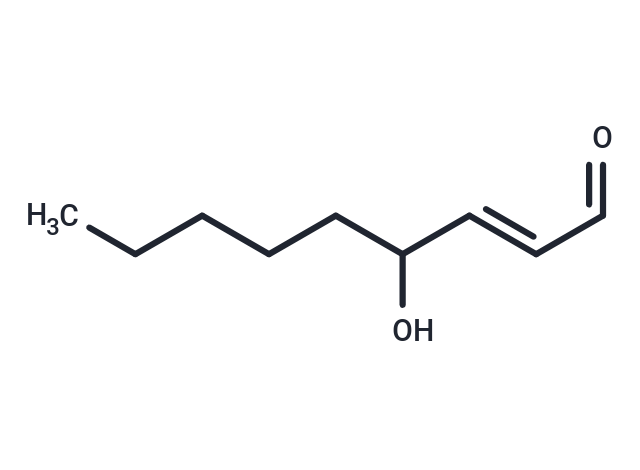Shopping Cart
- Remove All
 Your shopping cart is currently empty
Your shopping cart is currently empty

4-Hydroxynonenal (4-HNE) (4-HNE) is an oxidative/nitrosative stress biomarker. It is a substrate and an inhibitor of acetaldehyde dehydrogenase 2 (ALDH2).

| Pack Size | Price | Availability | Quantity |
|---|---|---|---|
| 1 mg | $48 | In Stock | |
| 5 mg | $98 | In Stock | |
| 10 mg | $171 | In Stock | |
| 25 mg | $323 | In Stock | |
| 50 mg | $522 | In Stock | |
| 100 mg | $756 | In Stock | |
| 1 mL x 10 mM (in DMSO) | $119 | In Stock |
| Description | 4-Hydroxynonenal (4-HNE) (4-HNE) is an oxidative/nitrosative stress biomarker. It is a substrate and an inhibitor of acetaldehyde dehydrogenase 2 (ALDH2). |
| In vitro | 4-Hydroxynonenal (4-HNE) is both a substrate and an inhibitor of ALDH2, with inhibition reversible at low concentrations and becoming irreversible at 10 μM. It induces antioxidant defense mechanisms to limit its own production and enhance cellular protection against oxidative stress. As a product of lipid peroxidation, 4-HNE is mutagenic and genotoxic in viruses, bacteria, and mammalian cells, reacting with all four DNA bases with varying efficiency (G > C > A > T). 4-Hydroxynonenal-dG serves as the best biomarker of its genotoxic effects, primarily found in nuclear DNA [1]. |
| In vivo | Twenty-four hours after fluid percussion injury (FPI), mouse brain tissue is analyzed for the expression levels of NADPH oxidase 1 (NOX1), inducible nitric oxide synthase (iNOS), and 4-Hydroxynonenal (4-HNE). Both wild-type (Nrf2+/+) and Nrf2-deficient (Nrf2-/-) mice show increased 4-HNE expression following a moderate 15 psi injury compared to uninjured controls. In Nrf2-/-knockout mice, 4-HNE expression is significantly higher than in corresponding injured and uninjured Nrf2-/-wild-type animals [2]. |
| Alias | 4-HNE |
| Molecular Weight | 156.22 |
| Formula | C9H16O2 |
| Cas No. | 75899-68-2 |
| Smiles | CCCCCC(O)\C=C\C=O |
| Relative Density. | 0.941 g/cm3 |
| Storage | Powder: -20°C for 3 years | In solvent: -80°C for 1 year | Shipping with blue ice. | |||||||||||||||||||||||||||||||||||
| Solubility Information | DMSO: 249 mg/mL (1593.91 mM), Sonication is recommended. | |||||||||||||||||||||||||||||||||||
Solution Preparation Table | ||||||||||||||||||||||||||||||||||||
DMSO
| ||||||||||||||||||||||||||||||||||||

Copyright © 2015-2025 TargetMol Chemicals Inc. All Rights Reserved.